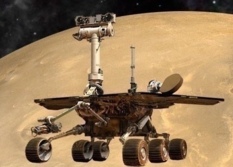A.J.S. Rayl • Apr 02, 2015
Mars Exploration Rovers Update: Opportunity Finishes First Marathon on Another Planet and Roves On
Sols 3946 - 3976
It began as a day like thousands of others for the Mars Exploration Rovers (MER) mission, but it ended in a way no other sol or Martian day ever will again.
On March 24, 2015, after spending several weeks investigating some new rock types along the western rim of Endeavour Crater, Opportunity roved past 42.2 kilometers (26.2 miles) and put the first off-Earth marathon in her rear view mirror, driving the Mars Exploration Rovers mission back into the space history books.
"This is the first time any human enterprise has exceeded the distance of a marathon on the surface of another world," said John Callas, MER project manager at the Jet Propulsion Laboratory (JPL), home to all of NASA's Mars rovers. "A first time happens only once."
The MER mission has a lot of experience actually with first times. Opportunity and her twin, Spirit, are the first two rovers to go over hill and dale on Mars...they are first to survive a planet circling dust storm, even though they weren't designed to withstand that kind of life-threatening Martian reality...the first to climb a mountain...first to drive into a crater...and the first to ground-truth the presence of phyllosilicates on Mars, clay minerals that are solid signs of past near neutral water on Mars, water like we Earthlings would drink – Opportunity is the first to rove onto that science gold.
Then last year, the veteran robot claimed the crown for long-distance champion of all off-Earth vehicles when she topped the previous record set by the former Soviet Union's Lunokhod 2 Moon rover. Indeed, the MER mission has chalked enough firsts to become a legend in its own time – and yet, a Martian marathon is an epic achievement.
Okay, so the finish time was 11 years and two months, but the prime directive of the MER mission has never been about setting distance records. “It’s about making scientific discoveries on Mars and inspiring future explorers to achieve even more," said Steve Squyres, MER principal investigator, of Cornell University. "As the mission goes on, we keep hitting new milestones, but this one, a marathon on Mars, is really cool. It means a lot as records go."
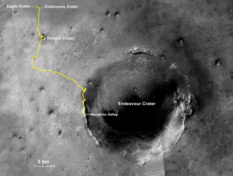
Opportunity's marathon course
The gold line on this image shows Opportunity's route from her landing site inside Eagle Crater, upper left, to her location after the marathon drive Sol 3968 (Mar. 24, 2015). Since August 2011, the MER mission has been investigating the western rim of Endeavour Crater, which spans about 22 kilometers (about 13.7 miles) in diameter. The mapped area is all within the Meridiani Planum region of equatorial Mars. The base image for the map is a mosaic of images taken by the Context Camera on NASA's Mars Reconnaissance Orbiter with the route added by Larry Crumpler of the New Mexico Museum of Natural History and Science.NASA / JPL-Caltech / MSSS / NMMNHS
Opportunity’s marathon is as symbolic a milestone as it is significant. Of course, it underscores, again, what an amazing engineering marvel this rover is. It also speaks volumes about why this rover that loves to rove – whose original, mission-success mobility objective was to drive 600 meters – is a robot hero that has captured hearts around the world. True to her MER mettle, she made it look easy and not being the kind of ‘bot to let such major achievements go to her masthead, she took it as all in a sol’s work and roved on.
But for the crewmembers who have devoted themselves to Opportunity, who have committed themselves to the MER team, and followed the old NASA mantra that ‘Failure is Not an Option” at every twist and turn and obstacle confronted on the Martian road, Opportunity’s marathon is a monumental moment on a mission that has been nothing less than arduously magical.
For many on the MER team, the marathon began before Opportunity landed. For some, including the team’s charismatic commander in chief of science, there were 16 years invested in just trying to get the mission going before the MERs launched in 2004. And in keeping the rover roving day in and day out for more than 11 years and counting, the human enterprise behind this rover evolved into model for success based on respect, gratitude, and dedication, as they demonstrated time and again what amazing things can happen when people actually work together.
“It really has been a marathon,” Squyres said. “And Opportunity’s marathon symbolizes this human team achievement.”
Even so, Oppy is one of them, and in honor of their rover’s achievement, members of the MER ops team will take a brief break and stage a marathon-length relay run at JPL on April 9, 2015 in celebration. Although Opportunity will still be busy on Mars, her Earth-locked stand-in, Bubba, is slated to rove the last leg and break the finish line ribbon.
Before logging her marathon milestone, Opportunity spent the early part of March studying a diversity of rocks along the section of the western rim of Endeavour Crater rising above Marathon Valley. “We have a highly diversified rim,” said Ray Arvidson, MER deputy principal investigator, of Washington University St. Louis. “We’re seeing signs of aqueous alteration and we’re also seeing that rocks tend to cluster in composition. This is very much a work in progress.”
Another work in progress, on the software engineering front, progressed in March and Opportunity got her long-term memory back. The rover’s onboard computer suffered amnesia events and dangerous unwanted reboots in 2014, most all of which were traced to one bank or sector in the flash drive, and last December the flash was taken out of commission. Since then, the robot field geologist had been operating in RAM mode, without flash.
But on March 19th Opportunity stood down from science and driving to reformat her errant flash drive. “At 1:30 am Friday morning, March 20th, we got the results that the rover had reformatted flash, the patch had successfully worked, and bank 7 in the rover’s flash drive was masked off,” said Rebekah Sosland, MER flight director and the lead on the flash tiger team that has been working the flash issue. “The data that came back was perfect,” she said, and the rover started using flash again “almost immediately.”
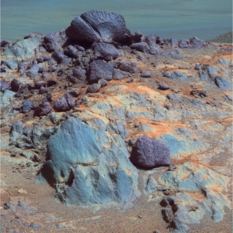
Floyd and Pryor
Opportunity took this image of Sgt. Charles Floyd, the 'blue' rock in the foreground, and Sgt. Nathanial Pryor, the 'purple' rock right next to it, with her Panoramic Camera (Pancam) on her Sol 3948 (Mar. 3, 2015). The Pancam team processed the raw images into this false color version, which allows scientists to better discern the various geologic features in a given scene.NASA / JPL-Caltech / Cornell / ASU
Opportunity and the scientists threw off the constraints of not having that long-term memory and picked up the science pace. With her campaign on the diverse rocks on Endeavour’s western rim done, the rover drove toward the Spirit of St. Louis Crater, taking lots of Panoramic Camera (Pancam) pictures along the way. “It's fantastic to have our flash capability back,” said Squyres. “What it really comes down to are the big mosaics – that's when you need flash the most. The big Pancam pans have become important scientific tools for us, because they provide us the view of the terrain we'd have if we were there with boots on the ground.”
Those lush Martian panoramas have also become the ‘image’ of the mission. It's what people ‘see’ when they think of Spirit and Opportunity, what they ‘see’ when they think of Mars. “All the images – the Microscopic Imager close-ups, the Navcams – are cool,” said Squyres, “but the big Pancam pans really open up Mars to us the way we'd experience it if we were there ourselves.”
As Opportunity drove into the apron area surrounding the shallow, oblong, odd-looking Spirit of St. Louis Crater, the scientists changed their robot’s plans. “We were going to proceed pretty crisply toward Spirit of St. Louis Crater, head in and check out the bizarre stack of rocks there, but as soon as we pulled onto the apron, we started to see these very intriguing patterns of light and dark markings in the rocks there and it was too intriguing to pass up,” said Squyres.
So the robot field geologist continued around to the southwestern edge, where an area of flat, particularly bright outcrops had grabbed the scientists’ attention. But late in the evening of March 25th, as the robot settled in to take a look at the chemistry of one of the bright rocks, she suffered an amnesia event, just five sols after the successful reformatting of flash. Fortunately, this misfortune was familiar. This amnesia event was just like the previous ones that occurred in 2014.
Amnesia meant Opportunity was unable to save her data to flash, so the data from the light-toned outcrop she had been working on was written to RAM, and the rover shut down for the night. Since RAM is volatile memory, the data was gone when she woke up the next morning. But the rover’s chemical detector, which she had been using, has its own non-volatile memory, so the data was read-out from the instrument’s memory and downlinked to Earth, and no science was lost.
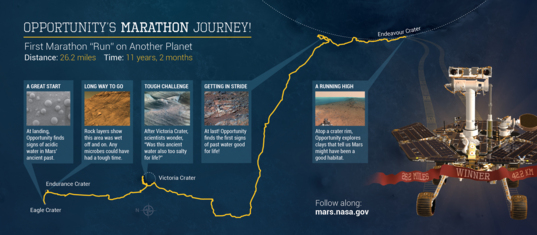
NASA / JPL-Caltech / Cornell / USGS / Arizona State University
Opportunity's epic run
This graphic depicts some of the highlights along the route Opportunity drove during the first 11 years and two months of her mission, from her January 2004 landing in Eagle Crater to the finish line of her marathon race. The rover surpassed a marathon distance of 42.195 kilometers (26.219 miles) with a drive on March 24, 2015, during her 3,968th Martian day or sol of exploration at Meridiani Planum, Mars. [For this map, north is on the left.]“We can live with amnesia events,” said Bill Nelson, chief of MER engineering at JPL. “They’re annoying, but we know how to work around them, and they’re not a threat to the mission. Especially since they continue to be, as virtually all of them have been, in the late evening, right before Opportunity goes to sleep.”
It had no impact whatsoever on Opportunity or on the mission’s planning. “It was a hic-cup,” said Callas. The rover kept on keepin’ on.
As April was peeking over the horizon, the robot field geologist was working away, examining another one of the bright outcrop rocks in the southwestern part of the apron surrounding Spirit of St. Louis Crater.
Despite Opportunity’s robot hero status, her marathon achievement, the bounty of discoveries she’s already made and the evidence of past water the MER team knows is waiting for the rover’s arrival in Marathon Valley, and regardless of all the ways she’s stood up to Mars to become the queen of surface exploration on the Red Planet and a true explorer survivor, there are humans on Earth who are threatening to end her mission.
The White House 2016 budget request for NASA, as reported in the January issue of the MER Update, allotted $0 dollars for continued operations of Opportunity even though it provided a 2.9% increase to NASA's budget overall. The comments of NASA Administrator Charles Bolden during testimony March 12th before the Senate Subcommittee on Space, Science and Competitiveness put Opportunity’s potential budgetary plight back in the news.
When Senator Cory Gardner (R-CO), one of the members of this committee noted the $0 budget for MER and questioned whether the decision to end Opportunity's mission was premature, Bolden responded: “We cannot continue to operate instruments and missions whose time has passed, because I won't be able to put something like InSight on Mars in 2016...I have to make choices."
The ‘missions whose time has passed’ comment in particular got people blogging and tweeting and left others shaking their heads. For more, see: “Is the Opportunity Rover a Mission 'Whose Time Has Passed’?”
The MER mission, however, has been down this rocky road before. Last year, the mission was zeroed out in the budget in 2015. However, like all exploration missions in extension, MER underwent the biannual Planetary Senior Review in 2014. Although MER is a Discovery type mission, it was ranked – based on terms of expected science return per dollar for next two years – second only to the Cassini mission to Saturn, a major flagship mission for NASA. As a result, the senior review board recommended in September 2014 that Opportunity be granted a two-year mission extension.
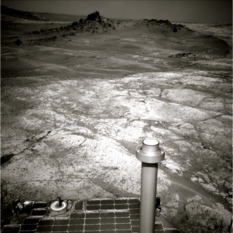
A marathon finish
When Opportunity rolled to stop on her Sol 3968 (Mar. 24, 2015), she took this image with her Navigation Camera (Navcam) to mark the end of her marathon. In this picture, the rover is in the polygonally marked apron area surrounding the shallow Spirit of St. Louis Crater, which is in the near distance. The intriguing stack of rocks inside the small, oblong crater that visibly rises higher than the crater rim has been named in honor of Charles Lindbergh, who flew the Spirit of St. Louis, on the first, solo, Transatlantic trip from New York to Paris in May 1927.NASA / JPL-Caltech
Most importantly now and in the big picture is the science MER is returning. It’s new. It’s relevant. It’s novel. Opportunity is the only robot investigating Noachian Period terrain, Mars’ original ground 3.7 to 4.2 billions years ago, when water flowed across and pooled on the surface as well as underground, the time when Mars was a lot like Earth. And this rover will be the only one on the ground in this terrain for who knows how long.
Even 11 years in, Opportunity’s work – as well as research from data that Spirit returned years ago – put MER in the ballroom spotlights alongside the findings from Curiosity and Gale Crater at the 46th annual Lunar and Planetary Science Conference (LPSC), held in The Woodlands, Texas, March 16-20.
From Arvidson’s presentation of the aqueous alteration of rocks that Opportunity found during the last year...to the talk by Brian Hynek (University of Colorado) on the chloride deposits and hydrologic activity in Meridiani Planum and the conclusion that they represent some of the last vestiges of inhabitable surface water on Mars as recorded in the mineralogical record...to the presentation by Larry Crumpler (New Mexico Museum of Natural History and Science) on how segmentation by transverse faults enhanced aqueous chemical alteration in specific locations along the rim of Endeavour crater...to the talk by Steve Ruff (Arizona State University) offering new observations of silica sinter deposits, produced in discharge channels from hot springs at El Tatio, Chile, favor the growth and preservation of microbes and provide a remarkable analog to the forms of silica observed adjacent to Spirit’s Home Plate in Gusev Crater, thus making “a strong case” for the Home Plate silica deposits being an ideal location for searching for past life on Mars...to the presentation given by Albert Yen (JPL) on the chemical signatures of weathering found in the Alpha Particle X-ray Spectrometer (APXS) datasets from Gusev Crater, Meridiani Planum, and Curiosity’s Gale Crater that reflect open system weathering where cations are mobilized in fluids and the resulting composition differs significantly from that of the precursor materials...MER was ever present in the spotlight lectures as well as sideline discussions, and posters presented at the annual planetary science gathering.
This much is certain: Opportunity’s findings continue to update textbooks and give the world deeper knowledge of the planet humans are willing to die for, just to attempt to explore it. No matter the vector – science, engineering, inspiration – this rover's ‘time’ has really just begun in so many ways. “We’re driving and we’re exploring,” said Callas. “We hit the distance record of a marathon, we’re in an exciting place, and the rover is doing magnificently.”
A new year however has bought a new budget. The American system of government and the accompanying politics that impact NASA’s budget are not easily explained or, perhaps, understood, but, in essence, there is a process that works something like this: the Office of Management and Budget (OMB) prepares a budget on behalf of the White House that includes the President’s established priorities and sends it to Congress.
The Senate, through its Subcommittee on Space, Science and Competitiveness, and the House of Representatives, through its Subcommittee on Space, hold hearings and weigh in. Then, after the dust settles so to speak, the budget goes back to the President for signing. Based on that signed budget, NASA puts together its operating plan.
Historically, the decisions for continuing extended missions are based on the senior review recommendations, which is the process NASA established long ago for granting mission extensions. “I think part of the reason Opportunity fared so well is because there was the sense that there is some very exciting science ahead at Marathon Valley and recent results are beginning to bear that out,” said Squyres. “As a result of that rigorous peer review, the recommendation was that Opportunity should be fully funded for next two years. I remain optimistic that NASA will follow that advice.”
Congress will also have a say and in the court of public opinion, Opportunity is a winner. “I’m confident that Congress will continue to recognize the value of this mission as they have from the very beginning,” said Callas.
So, as NY Yankee great Yogi Berra so famously quipped: “It ain’t over ‘til it’s over."
Past that, the MER team members aren’t spending their energy or time looking over their shoulders or worrying. There’s just too much going on right in front of their Opportunity, not the least of which are the really bright outcrops before her. “I thought we'd be wrapping things up, but what we saw in the latest images is so interesting that we decided to spend a couple more sols here,” said Squyres.
Whatever the robot field geologist discovers in the light-toned outcrops, it won’t be long before she enters the strange Spirit of St. Louis Crater to check out the even stranger rock structure inside the crater. Rising higher than the crater rim, like a Martian cairn, the strange stack of rocks has been named Lindbergh Mound, after Charles Lindbergh, who flew the first, solo non-stop flight from New York to Paris in 1927.
And then, Opportunity will rover on, taking a short jaunt of 100-150 meters to drive into Marathon Valley, where a mother lode of various kinds of clay minerals and more evidence of the ancient wet environment in this area 3 to 4 billion years ago, are there for the mission’s taking.

NASA / JPL-Caltech / Cornell University / Arizona State University
Marathon Valley overlook
This view from Opportunity shows part of Marathon Valley as seen from an overlook north of the valley. The landscape is presented in false color, a process that makes it easier to see differences in surface materials. The scene spans from east, at left, to southeast and combines four pointings of the rover's Pancam on March 13, 2015, the rover's Sol 3958. The image combines exposures taken through three of the Pancam's color filters, centered on wavelengths of 753 nanometers (near-infrared), 535 nanometers (green) and 432 nanometers (violet), at each of the four camera pointings.After checking out Jean Baptiste Charbonneau, a new type of rock rich in aluminum and silica, in February, Opportunity drove toward some other similar looking rocks nearby. When the robot field geologist opened her Pancam eyes on the first sol of March, she was positioned perfectly to approach the target rocks the scientists had selected for a close-up examination.
It was a good first sol of March on Mars. With 42.084 kilometers (about 26.15 miles) on her odometer, the solar-powered rover began the month with plenty of power, producing 545 watt-hours, more than half her total capability. The atmosphere was typically hazy, and Opportunity measured the opacity or Tau at 0.708, normal for a Martian summer. Her solar array dust factor remained a respectable 0.687, meaning she was utilizing 68% of the sunlight hitting her winglets.
On Sol 3948 (March 3, 2015), Opportunity bumped forward just under 4 meters (about 13 feet) to put the chosen rocks and candidate targets within reach of the science instruments on her Instrument Deployment Device (IDD) or robotic arm. She was still operating in RAM mode, storing her science and engineering data in her random access memory (RAM) and then transmitting it to the Mars Odyssey orbiter before she shut down for the night.
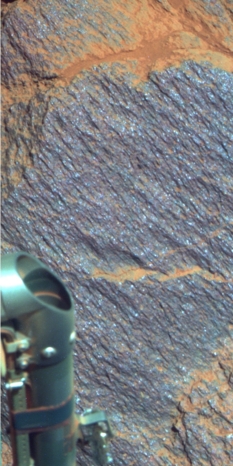
Jean Baptiste Charbonneau
Opportunity spent much of the second week of February 2015 conducting an in-depth study of the intriguing rock called Jean Baptiste Charbonneau. The robot field geologist took this image with her Pancam on Valentine's Day. It was processed in false color by the Pancam team. In March, the rover found another similar rock, which is now known as Sgt. Nathanial Pryor, after one of the members of the Corps of Discovery, more popularly known as the Lewis & Clark Expedition. Both are high in silica and aluminum and unlike other rocks the mission has found.NASA / JPL-Caltech / Cornell / ASU
The flash tiger team that uplinked and installed the rover’s new R9.4 flight software in February, however, was planning to send the command to reformat the flash drive and mask off the suspected corrupted sector or bank as soon as Opportunity finished her work on this new collection of rocks.
The robot field geologist pulled out her Rock Abrasion Tool (RAT) on Sol 3950 (March 5, 2015) and brushed a spot Sgt. Charles Floyd, a rock named after a member of Corp of Discovery, known as the Lewis & Clark Expedition. Following the routine protocol, she placed her Alpha Particle X-ray Spectrometer (APXS) on the target spot to determine its chemical make-up.
Data volume constraints with her Ultra High Frequency (UHF) antenna caused Opportunity to postpone taking the multiple pictures necessary for a full Microscopic Imager (MI) mosaic of Floyd until Sol 3952 (March 7, 2015). But as the first week of March came to an end, the rover had completed the assignment as planned.
As the second week of March set in, the scientists were considering having Opportunity grind into Sgt. Charles Floyd on Sol 3955 (March 10, 2015). But the analysis of the images and data indicated that Floyd would be a tough grind and likely cause excessive wear on the RAT bit. “The rock also appeared to be relatively dust and coating-free,” said Arvidson. So instead of digging into Floyd, Opportunity bumped 0.2 meters (about half a foot) to face Sgt. Nathaniel Pryor, which she had imaged with her Pancam.
By taking images of rocks, outcrops, and terrain with longer wavelengths, a feature the Pancam offers, and then processing the images in false color, the scientists are able to see differences among the rocks and other geologic formations. “It makes the rusty red dust and oxidation a little more transparent and that allows us to see deeper into the rock and see intrinsic colors, although they are false colors,” Arvidson said.
In the colorful false color Pancam images of these new rock types, one of which is presented with this report, Sgt. Charles Floyd appears blue, while Pryor, like Charbonneau, appears purple. But to be clear, if you were standing next to these rocks on Mars, they would not be blue or purple but rusty, dusty Martian red. “To the eye, everything on Mars is red,” said Arvidson.
While Opportunity’s bump to Pryor was successful, when she straightened her wheels, the movement knocked the IDD slightly out of alignment with the target, so she did a small tank turn on Sol 3957 (March 12, 2015) to make things right. The robot field geologist then spent the rest of the second week of March, taking some early and late afternoon Taus with her Pancam and Navcam, and lots of pictures of her surroundings, including detailed, Pancam pictures of Sgt. Charles Floyd using all 13 filters of the stereo camera, and images of the eastern part of Marathon Valley floor.
On Sol 3959 (March 14, 2015) Opportunity took more Taus and an albedo pan, and then placed her APXS on a spot on Pryor for an integration she would initiate after transmitting her data to Odyssey for downlinking to Earth.
Mars seemed to be smiling on the robot as Opportunity’s energy production climbed above 575 watt-hours in the middle of the month. Her solar array dust factor improved to 0.725. At the same time, the skies overhead became a little less hazy, with the Tau dropping to 0.658.
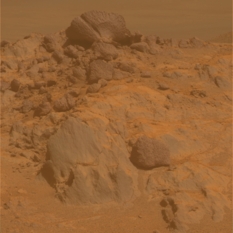
It's all red
This image of Sgt. Charles Floyd and Sgt. Nathanial Pryor, two of the new rock types that Opportunity investigated in March 2015, is the same image as the false color image presented above, but was processed in true Martian color to show what the rocks and this scene on Mars would look like if you were standing next to the rover. “To the eye, everything on Mars is red,” said MER Deputy Principal Investigator Ray Arvidson.NASA / JPL-Caltech / Cornell / ASU
The rover spent the second weekend of March taking more early morning and late afternoon Taus. “One of the reasons for doing early and late Taus is that we look through a different column of air,” said Nelson. “If Opportunity takes a Tau at noon with the Sun overhead, it’s looking directly through the atmosphere, a relatively short distance. But when the rover takes a Tau late in the day, it’s taking a slanted look through the atmosphere, through a much longer column of air.”
The change in Tau between those two measurements allows the MER team to estimate how much dust Opportunity has on her camera optics as opposed to how much dust is actually in the atmosphere. “And that enables us to get a better handle on where any error sources may be in these Taus,” Nelson said.
Opportunity began the third week of March on Sol 3960 (March 15, 2015) taking MI images of the APXS target spot on the Pryor rock, and then continuing her chemical sleuthing into Pryor. The next sol, she took a routine, early morning Tau, then used her Pancam to take images of geologic features not so creatively named Vein 2 and Vein 3, as well pictures of outcrop to the south, Speckled Hill, ending a long sol with another late night APXS integration on Pryor.
By Sol 3962 (March 17, 2015), the robot field geologist was wrapping up her investigations of Floyd and Pryor. After taking a morning Tau, she turned her Pancam eyes to take more 13-filter images of the Floyd and Pryor rocks that she’d been investigating. Then, she headed out, en route to the shallow, elongated Spirit of St. Louis Crater that guards the entrance of Marathon Valley.
Although the scientists are still analyzing the data on the Charbonneau, Floyd and Pryor rocks, at the end of the Martian sol, they’re all basalts. “It may be a little bit like splitting hairs,” said Arvidson. “It’s not like we found granite. But the diversity we’re seeing is important and a part of a bigger picture here.”
Moreover, since arriving at Endeavour Crater, the scientists are also finding localized clusters of rocks that have been altered by water in different ways. “So there’s the soil, which is kind of an average over some spatial scale that we’ve been measuring,” said Arvidson. “Then we looked at Ulysses Crater on Wdowiak Ridge and that set of measurements tends to cluster a little bit differently from the soils,” he said. “Now Charbonneau and Sgt. Nathanial Pryor are enriched in silica and aluminum relative to the other rocks, and then Sgt. Charles Floyd, the ‘blue’ rock, is also a little bit different. And it’s different than the Ulysses Crater rocks we measured, and different than most of the Shoemaker Formation.”
So what does all this mean?
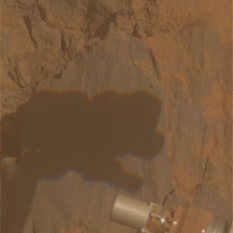
Shadow puppet?
Opportunity wasn't playing shadow puppets when she took this image of Sgt. Charles Floyd. Rather, the robot field geologist was just moving in close to get a good look at this new rock type among a collection of diverse rocks she found along the western rim of Endeavour Crater in March 2015. "We're still working on this," said MER Principal Investigator Steve Squyres, "so we don't have anything new to say about this rock, yet."NASA / JPL-Caltech / Cornell / ASU
Figuring that out is the MER scientists’ challenge. “The goal now is to put the whole picture together in terms of the impact dynamics and evolution of the rim with degradation, alteration, and whatever else happened to these rocks,” said Arvidson. “What we need to do is relate the odd compositions of the these rocks to what we’ll see on the apron of Spirit of St. Louis Crater, and what we’ll be seeing soon on the floor of that crater and those blocks of rocks that are jutting off Lindbergh Mound, and then also with what we find in Marathon Valley.”
Opportunity and her team wasted no time. The rover put 28.28 meters (97.78 feet) behind her on Sol 3962 (March 17, 2015) driving toward the strange shallow crater. When she stopped, she took the usual post-drive post drive imaging, using her Navcam and HazCam for the distance and terrain evaluation needs of the rover planners, and began a 360 Navcam panorama that she would complete the next sol.
Meanwhile, around the same time on Earth, the MER flash tiger team was ready for Opportunity to initiate the patch in her R9.4 flight software that would reformat flash and mask off the corrupted bank 7. “We wanted to wait a while and let the rover ‘soak’ on the new flight software so that we knew that everything was working the way it’s supposed to work,” explained Sosland.
By mid-March, that R9.4 ‘soak’ period was over. “On March 18th, we wrote the commands for the flight software to execute the reformat, sent it up to the vehicle on the following day, and Opportunity reformatted flash and masked off bank 7,” Sosland reported. “We asked the science team to not drive or use the IDD instrument that sol, just to give the flash trial system some time to initialize and us some time to make sure that it was behaving appropriately. We didn’t want the system to freak out or somehow negatively affect one of the instruments.”
But everything went like clockwork and in the very early morning hours of March 20th, Sosland and her team received confirmation from Opportunity that the reformatting completed successfully. “The event records (EVRs) were flawless,” she said. “Basically, they showed us that that we are on our R9.4, that we were using the six banks of flash just like we expected, and bank 7 had successfully been masked. The rest of the EVRs showed no signs of flash errors of any kind. They were perfect.”
The MER software engineers tried to clear bank 7 manually after the reformat, “but there’s still stuff in there,” said Nelson. Whatever it is, it is of no consequence now. Bank 7 is kaput. Opportunity’s computer will now automatically avoid using that sector, relying on the six other banks available to it for data storage. [There is one bank devoted to data other than science data.]
Opportunity, as always, was raring to go. Once Sosland gave her report to the team, the rover planners sequenced the rover’s next drive “right then and there,” she said.
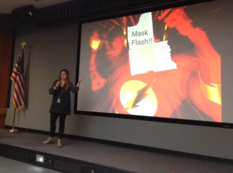
Flash reformat
Becka Sosland, MER fight director and the lead engineer on the flash tiger team, gave a report to the MER team on March 20, 2015 at JPL, just hours after her team got the news that Opportunity had successfully reformatted her flash drive, masking a corrupted bank on the drive and putting her long-term memory back online. The rover and the team began using the flash "almost immediately," Sosland said.Steve Collins
Although the rover proved during the last three months that she can work productively without the use of flash memory, having flash gives the mission greater flexibility, “because it allows data from intensive science activities to be returned over several days,” said Callas.
The MER team members are thrilled to have flash back in service. “When you don't have flash available to you, your ability to show Mars as it really looks becomes somewhat limited, because the rover cannot take as many big Pancam panoramas,” said Squyres. “To have that limitation removed is great. We got a beauty from last weekend on the way now...there's just big picture stuff we can do when we have flash.”
For Sosland and the flash tiger team, this latest flash reformat was an achievement that was months in the planning. “The flash masking was an important process, an important and difficult task that the team really figured out how to do, and do correctly,” said Callas.
On Sol 3966 (March 21, 2015), the engineers “gave the keys back to the scientists,” as Nelson put it. Opportunity took some targeted Pancam imagery, including pictures of Swann Hill on Endeavour’s rim to the southeast, a small crater dubbed Genesis, and a target outcrop dubbed Sgt. John Ordway. Then, she roved on.
Heading west and then south for 54.18 meters (about 177.75 feet), Opportunity took a dogleg path to avoid obstacles along the way and drove onto the polygonally fractured apron area surrounding Spirit of St. Louis Crater. At drive’s end, she followed the mission protocol and took the usual images of her new location.
The plans had been for Opportunity to promptly drive into Spirit of St. Louis and up to Lindbergh Mound to check it out. But once the scientists took a look around in the images, they knew their rover “had gotten into something different,” said Squyres. “When we saw the Navcam panorama images, we knew we had a puzzle we had to sort out. These rocks do not look like Shoemaker breccias. We had to stop for a while.”
Opportunity began the last week of March taking some Pancam pictures, a 360-degree Navcam, and routine Taus as her team on Earth took it all in. The rover used her Pancam to take pictures of Marathon Monument, and multiple filter images of Spirit of St. Louis Crater on Sol 3968 (March 24, 2015). And then, during the overnight hours of March 23rd to March 24th for the rover ops team at JPL, the rover on Mars woke up and took a 46.9-meter (154-foot) dogleg trek around to the southwestern side of Spirit of St. Louis Crater.
It was on that drive that Opportunity made marathon history, cruising past 42.195 kilometers (26.219 miles), and ending her run with 42.230 kilometers (26.241 miles) on her odometer.
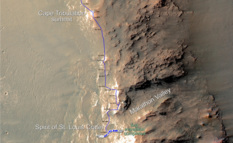
Marathon final leg
This map shows the southward path Opportunity took along the west rim of Endeavour Crater from late December 2014 until she passed marathon distance on March 24, 2015. On recent drives, the rover moved into the apron area surrounding Spirit of St. Louis Crater. In coming weeks, the rover will enter the small, oblong crater, study the unusual stack of rocks there, called Lindbergh Mound, and then drive into Marathon Valley.NASA / JPL-Caltech / UA
“Throughout the years, we have set these records – 8 years, 10 years, 40 kilometers, then exceeding Lunokhod 2 – all these milestones that are in a sense arbitrary, and which one means the most varies from person to person,” reflected Squyres in the days after Opportunity’s big achievement. “For some reason, I'm finding this marathon has more meaning for me than some of others have had. Partly it’s because for many years I was distance runner. The other thing is that we always, in the English vernacular, use the word ‘marathon’ to describe any feat that requires real endurance.”
While Opportunity made history with her marathon – and that history required the endurance of hundreds of people as well as rover stamina – the word ‘marathon’ has its own history.
“It’s a distance that holds historic importance for us, because the origin of the marathon, 25 centuries ago in ancient Greece, successfully repelled an invasion from Persian forces at the battle of Marathon,” said Callas. “That battle, many historians have argued, was the pivotal moment in the preservation of civilization’s first experiment in democracy.”
During the Battle of Marathon in 490 BC, the citizens of Athens and Plataea fought against a mightier Persian force during the first Persian invasion of Greece, commanded by Datis and Artaphernes. The battle effectively ended the first attempt by Persia under the rule of King Darius I to subjugate Greece and marked a turning point in the Greco-Persian Wars.
“So the marathon represents something very important in human history,” Callas continued. “Now we’ve extended that history to another world. For the first time, our species has demonstrated the capability of a human scale enterprise in duration – 11 years, two months – and a marathon in distance, and in discovery on the surface of another planet. We’ve demonstrated that we can build robotic systems that can match human endurance distance limits on the surface of another world. That’s one of the reasons why I regard this marathon achievement as significant, especially for a rover that was designed for 90 days and 1 kilometer,” he added.
Given the history, at Callas’ suggestion, Opportunity targets are now being named after Greek places. And so, on Sol 3969 (March 24, 2015), as March wound down, the rover drove 8.5 meters (27.88 feet) to particularly bright area in the southwestern corner of polygonally fractured apron that surrounds Spirit of St. Louis Crater and stopped in Athens.
During the next couple of sols, the robot field geologist took the routine Pancam Taus, completed a 360-degree Navcam panorama, snapped pictures of the flat, light-toned rock dubbed Athens and a nearby outcrop dubbed Thermopylae, used her APXS to take a measurement of argon in the atmosphere as part of a mission-long study, and later used that same instrument to sniff out the chemical composition of Athens. Then, late in the evening of March 25th, as she was working on Athens, Opportunity suffered an amnesia event.
It was an amnesia event like most all the other amnesia events. “Typically, after an APXS integration, the rover will wake up around 23:15 or so, about 11:15 pm PDT, to do a read-out and then shutdown for sleep,” said Nelson. “It’s that wake-up and before the rover goes to sleep that it suffers amnesia.
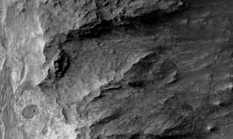
Opportunity's location
This image, taken by the HiRISE camera onboard the Mars Reconnaissance Orbiter, shows Spirit of St. Louis Crater (lower left) at the entrance to Marathon Valley (to the right or east of crater). Author, MER poet, planetary educator, and member of UMSF.com, Stuart Atkinson added a dot to represent Opportunity in her approximate location at the end of March 2015. The bright outcrops, which the robot was checking out at the end of the month, are clearly visible. Click to enlarge. For more of Atkinson's work, check out his: The Road to Endeavour.NASA / JPL-Caltech / UA / S. Atkinson
Why Opportunity suffered another amnesia event after successfully masking the corrupted sector is a mystery. “One of the problems with the amnesia events is you have no data there’s not a lot of grist for the mill,” said Nelson. “And it’s not something that we can simulate here on Earth, because we don’t have the same problems with our flash. We need that particular flash to do the testing. It’s kind of an intellectual black box to us, because it’s purchased intellectual property.”
The company that made the flash drive no longer support it,” said Nelson. “They don’t even have employees who remember it. “They’re 10 or 15 generations beyond that flash system now, and the people who actually worked on the version Opportunity has have retired or left the company.”
Further complicating the effort is the fact the original product licensed, TrueFFS (True Flash File System), was the product of M-Systems Ltd., an Israeli company subsequently acquired by SanDisk in 2006.
So, despite the successful reformatting of flash, the engineers still don’t know the exact root cause of the problems, said Callas. “We have a strong suspicion that some of the problems, maybe the most serious ones, are associated with bank 7, which perhaps we have corrected by masking off bank 7 as we did. But it may not clear up all the problems. There may be more than one problem with this flash system.”
It’s the not knowing that’s the hardest part. “It had been such a huge week for the rover – we had successfully masked off bank 7 and got flash back in service immediately, and then we hit the ground running, passing the marathon just a couple of sols later – it was incredible,” Sosland reflected at month’s end. And then the amnesia event.
“At first, I was frustrated; we hoped by masking off bank 7, all flash-related anomalies would have subsided but, after speaking with the team, we realized that this amnesia event actually provides useful information without causing any harm to the vehicle,” said Sosland. “We are almost certain that bank 7 is not responsible for the rover’s recent amnesia and that we should be looking in other areas for the root cause of these events.
Interestingly, there is a notion floating among the engineers that it might be temperature related. “But the rim at that time is actually kind of mid-temperature, still coasting on the heat from the day,” said Nelson. “So it’s not as cold as it’s going to be, and yet it’s well after sunset, so it’s not as warm as it has been. It’s midpoint.” So at the moment, that theory remains a mystery too.
What they do know is that Opportunity’s amnesia bouts are not mission-threatening. “They’re not even a threat to data, because of when they happen, and the APXS instrument has its own non-volatile memory onboard, so there’s no science loss,” reiterated Nelson.
“The amnesia events are one of the most benign symptoms of the flash issue[s], and we can live with it forever, added Callas. “It will have practically no impact on science or exploration. We don’t remember our dreams when they happen, but everything else is fine.”
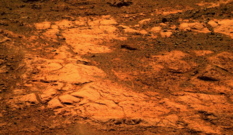
Athens
Opportunity took this image of Athens and "friends," the really bright, flat, light-toned outcrops she was studying at the end of March 2015, located in the apron area of Spirit of St. Louis Crater. The rocks are reminiscent of the oldest strata the mission has uncovered, the Whitewater Lake formation rocks she studied on Matijevic Hill in the Cape York segment of Endeavour's eroded western rim in 2012-2013. "It would be really, really easy to get fooled here," said MER PI Steve Squyres. "We’re making measurements and going to try and figure it out.”NASA / JPL-Caltech / ASU / S. Atkinson
If Opportunity’s bouts of amnesia should become persistent, “then it becomes more annoying,” said Nelson. The amnesia, however, is enough of a concern that there is talk about bringing in a bright young computer science intern onboard and “turning him/her loose” to see what might be found.
Until any new news turns up on this front, the plan is for Opportunity “to continue happily on six banks of flash, and monitor her if she has any more amnesia,” said Sosland.
A little amnesia though wasn’t about to stop this rover. On Sol 3970 (March 26, 2015), Opportunity brushed Athens with her RAT, took the pictures for an MI stereo of Athens, and then placed her APXS on the rock to determine its chemical make-up. The robot took more Pancam images of Athens and another nearby outcrop Plataea on the following sol, 3971 (March 27, 2015), and then bumped to Thessaloniki, another outcrop in the bright area in the apron around Spirit of St. Louis Crater. That’s where the rover would spend the rest of the March.
While the MER scientists are in the midst of reviewing and analyzing the data coming in from the bright rock outcrops, Arvidson ventured an early, working hypothesis: “This looks to be an area that is probably a leach zone, where hot fluids came through and removed the iron and other materials that make things dark,” he said.
As the calendar turns from March to April, the plan ahead is for Opportunity to complete her work on the bright outcrops. “We saw in the MIs some discontinuous dark coatings, reminiscent of things we saw at Matijevic Hill,” said Squyres. “I'm not saying it's the same thing, because we don't know yet, but the discontinuous dark coatings we’re seeing, to my eye, look similar to what we saw on Matijevic Hill. They are thinner, like little flakes of stuff, but the coatings are there.”
The coatings Opportunity found on rocks on Matijevic Hill, you may remember, turned out to be remnants of clay minerals that once long, long ago might have been a haven for the emergence of lifeforms, the phyllosilicates that the mission was looking for.
Rather than drive away, the MER team decided to have Opportunity do some more APXS work on these bright outcrops, with several off-set measurements to see if they can disentangle the composition of the coating from the composition of the underlying rock. “We were drawn to this part of Mars by an infrared signature from orbit that looks similar in many respects to what drew us originally to Matijevic Hill, so we are naturally going to be looking for Matijevic Hill-like things,” Squyres said. “But we haven't seen any newberries and it would be really, really easy to get fooled here. We’re going slow and making measurements and going to try and figure it out.”
Once her work in this area is done, Opportunity, if everything goes as planned, will drive the some 30 meters into Spirit of St. Louis Crater. “This crater is so enigmatic,” said Arvidson. “It’s very shallow and has this crazy mound of rocks, Lindbergh Mound, which is not even in the center but displaced to the east. We’ll look at some of the blocks that have rolled off of it and try to answer what exactly is going on. Do these rocks represent yet another rock type? Are they blue rock types, or like Ulysses rocks? They we’ll explore the crater to try to determine if it was formed by a low velocity impact from ejecta – or whether it’s volcanic – and whether it is something else. The ideas are all over the place. So we need to make some measurements.”
Then at long last, Opportunity will drive another 100-150 meters and into the Marathon Valley proper, where MER scientists know there are discoveries and Martian riches and mysteries awaiting their arrival. The rover is ready, despite increasing dust in the atmosphere.
At month’s end, Opportunity was producing 549 watt-hours of power, plenty of energy to drive and work. Although the Tau rose to 0.976, her solar array dust factor was hovering around 0.745. “Summer is a dusty time of the Martian year and there have been some regional storms to the west of the rover site,” said Nelson. “These pose no threat to the rover – they're on the order of 1000 km away – but they do loft dust into the atmosphere which is why we're seeing more elevated Tau values. Even so, this is expected and consistent with prior Martian years.”

NASA / JPL-Caltech / Cornell / ASU / S. Atkinson
Lindbergh Mound Panorama
Opportunity took this image with her Pancam in mid-March 2015 as she was driving in the apron area surround Spirit of St Louis Crater. The stack of rocks now forever to be known as Lindbergh Mound, is front and center. Stuart Atkinson processed this Pancam image in his Martian 'technicolor' style. For more of Atkinson's work, check out his: The Road to Endeavour.Overall, Opportunity is in “remarkably good health,” said Nelson. “The amnesia event does have us a little concerned, but everything else seems to be working pretty much as it always has. The wheel currents are well behaved. Our energy output is good, and we’re in a pretty thermally benign part of the year.”
“We still have lots of capability in this rover. The capability of the Opportunity hasn’t diminished in several years,” summed up Callas. “The thing about marathoners though is they just don’t want to do one. They keep doing them. So the question is, what’s next?”
Hmmm. Maybe that’s why talk of other craters like Iazu or Bopalu is wafting through the MER hallways. “We still have business to do here,” Callas said. “And we still have an extended mission science plan that we need to execute. So we’re focused on that. We’re going to get that done first.”
Let’s Go Beyond The Horizon
Every success in space exploration is the result of the community of space enthusiasts, like you, who believe it is important. You can help usher in the next great era of space exploration with your gift today.
Donate Today

 Explore Worlds
Explore Worlds Find Life
Find Life Defend Earth
Defend Earth


